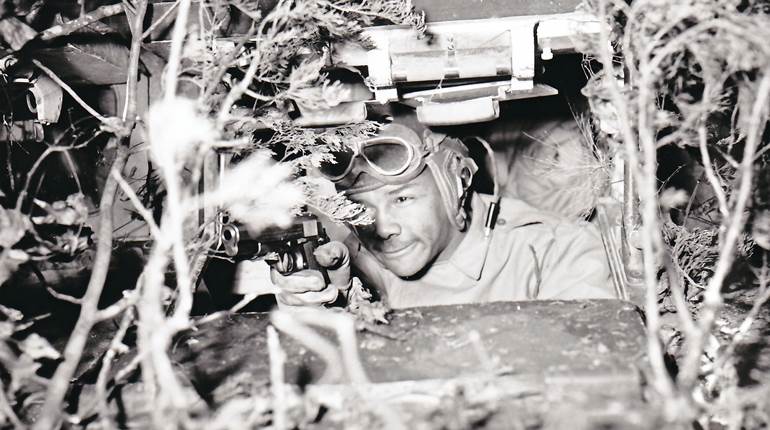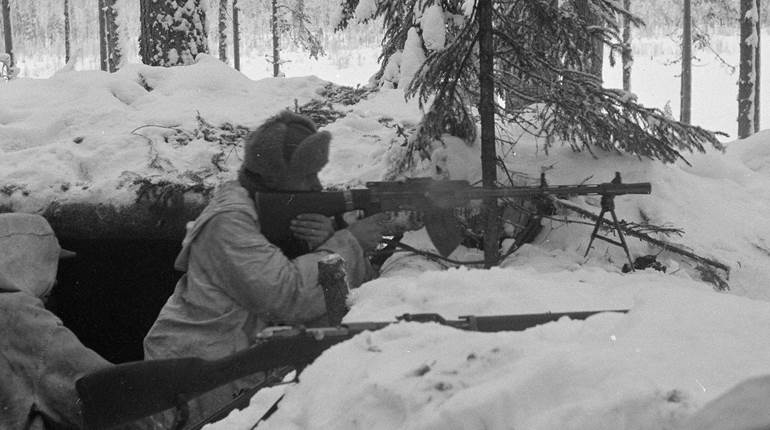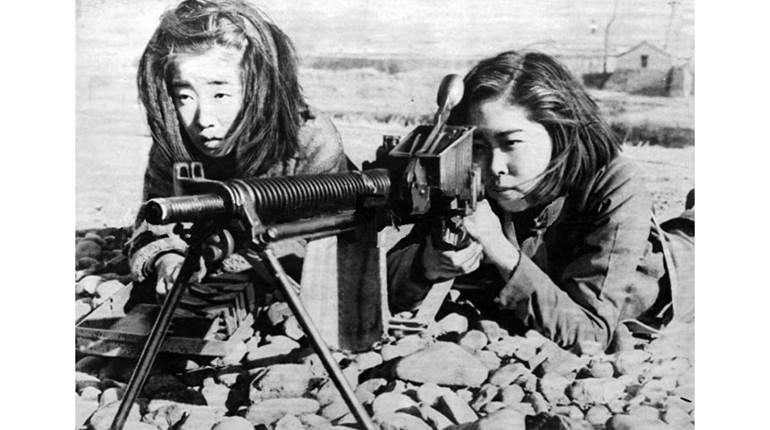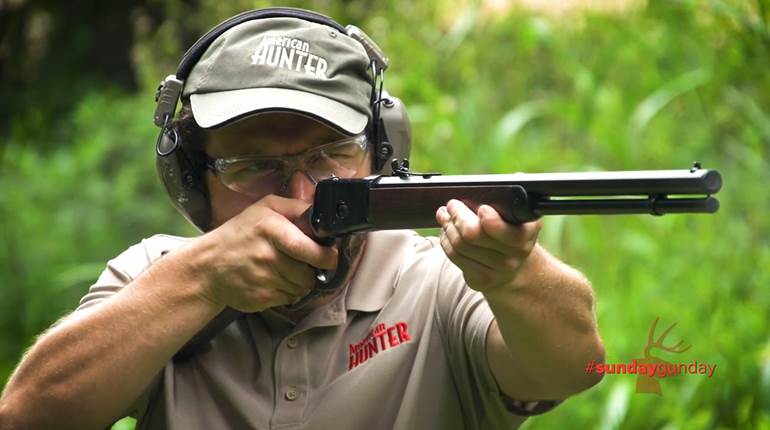
The most commonly issued machine gun to the American Expeditionary Force (AEF) was the gas-operated French Model of 1914 Hotchkiss in 8x50 mm R Lebel. The height of the “Omnibus” tripod (above) was one of the Doughboys’ few complaints. The other was weight—111 lbs.
A century ago, American troops faced Germans in the trenches and fields of France. The United States had entered the war a year before, in April 1917, as a fresh-faced member of the Allied cause—full of energy but lacking many of the essential tools of war. Later in 1917, elements of the American Expeditionary Force (AEF) arrived in France, but they did so without machine guns. Sufficient guns were not yet available in the United States, and, to complete their equipment as a modern fighting force, it was decided the Doughboys would be equipped with American-made rifles, but light and heavy machine guns would be purchased from the French or British, depending on where the units were sent. Most American troops received French automatic arms.
Through no fault of their own, the Doughboys were issued the French Fusil Mitrailleur Modele 1915 CSRG (Automatic Rifle, Model 1915) or “Chauchat”—the most widely manufactured automatic arm of the Great War. How American troops made the flawed Chauchat work for them is a story that has already been told (October 2012, p. 70).
The flip side to that story was the issue of the excellent French Model of 1914 Hotchkiss heavy machine gun, which served as the AEF’s primary heavy machine gun. Chambered in the 8x50 mm R Lebel cartridge, the Mitrailleuse Automatique Hotchkiss Modele 1914 proved to be accurate, reliable and adaptable. Its design was based on principles set out by an Austrian cavalry officer, Baron Adolf Odkolek von Ujezda, and it was acquired and then refined by a Paris firm founded by an American, Benjamin Hotchkiss.

An account from Co. D, 109th Machine Gun Btn., 28th Division, describes the training: “June 16—Got off train at Esbly [France] and hiked to trucks. Rode to Trembly and hiked back five kilo, to Roissy … . Here Hotchkiss Machine Guns were issued, and … many of the companies at this time received a severe training under French instructors.”
The way of the machine gun is both art and science. The Doughboys had a lot of catching up to do in order to be competitive with the Kaiser’s experienced men, and that was described in the History of the 101st Machine Gun Battalion: “By the end of December practically every man was thoroughly familiar with the handling of the Hotchkiss gun. Before the month of January was over, it might be said that the Battalion was well trained. They were far from veteran troops, but at least each man understood his gun, which is the essential for a machine-gunner.

“Every effort was made to find a place where indirect fire could be carried on, but it was impossible to locate a range near Mont where there was no danger of ricochets landing in some nearby village.
“At last, towards the end of January, all the machine guns of the Division were assembled at an old French artillery range on the outskirts of the Divisional area, and a chance was given to fire an overhead barrage. The machine guns of the Division, 168 in number, were put into action with an interval of five yards between each gun. Each Company Commander was given a map showing his gun position and the target assigned to his company, and told to calculate the necessary data.
“At a given signal all guns opened fire at once. Observers gave reports for the proper adjustment of the fire. It was a remarkable sight.
“During the barrage Colonel John Henry Parker, who was chiefly responsible for the assembly, drove his automobile back and forth under the hail of bullets, thereby conclusively demonstrating to every man on the field, that troops could advance with safety, under cover of a barrage laid down by machine-guns.”
By 1917, the M1914 Hotchkiss machine gun had become the standard French heavy machine gun. American troops arrived as Hotchkiss production was in full swing, and the AEF acquired more than 5,200 M1914s before the end of the war. The air-cooled M1914 was unique in an era dominated by water-cooled machine guns, such as the Maxim, Vickers and Schwarzlose. The gas-operated Hotchkiss fires from an open bolt, and its barrel is particularly heavy. The distinctive donut-shaped cooling rings on the barrel were noted to be particularly effective in dissipating heat.

The Hotchkiss was a relatively simple design, reliable and easy to manage. Without the tripod, the gun itself had only 32 parts—and has no screws or pins. The barrel was relatively easy to change when overheated. Reliability comes at a price, though, and with the Hotchkiss that price was its weight. The gun and its tripod totaled 111 lbs.
All told, Doughboy complaints about the Hotchkiss machine gun were few. The “Omnibus” tripod was deemed too heavy and much too tall. American units often modified their Hotchkiss tripods to lower them. The other big complaint focused on the ammunition feed-strip system. The loading strips came in either 24- or 30-round configurations, and while they were simple enough to load, the system inhibited extended firing. During 1918, a 250-round, “semi-articulated” metal ammunition belt was introduced. These were predominately used with Hotchkiss guns mounted in French tanks (which were used by the Tank Corps of the AEF), or in anti-aircraft units using the Hotchkiss.
The unit history of the 101st Machine Gun Btn.—part of the 26th Yankee Division—provided some interesting details on their use of the Hotchkiss M1914 guns:
Ordnance Equipment:
Machine Gun:
French Hotchkiss Model 1914
Caliber: 8 mm
Weight of Equipment:
machine gun - 53 lbs.
tripod mount - 58 lbs.
ammunition case, loaded with 12 strips (288 cartridges) - 28 lbs.
Number of rounds machine gun ammunition fired by the Battalion: 1,112,228
Number of machine guns replaced: 52
Number of guns hit in action: 7
Number of barrels replaced because of wear: 8
Looking at wartime reports and unit histories, the Hotchkiss machine gun is rarely mentioned. Ultimately, this is a sign of the gun’s great reliability. It was always there, ready for action, and the Doughboys trusted it.
As much as we like to celebrate John Moses Browning’s genius design—the U.S. Model of 1917 machine gun—the water-cooled, recoil-operated Browning gun spent little time in combat during World War I. The French Hotchkiss was the primary heavy machine gun employed, and the Doughboys put it to good use in some very bad situations.
Laurence Stallings’ book The Doughboys (Harper & Row 1963) provides a look at the grit and courage of the American troops, and their quickly acquired skills with machine guns. In his chapter on the “Lost Battalion”—nine companies of the 77th Division in the Argonne Forest, October 1918—Stallings describes how the German commanding officer sent a captured American corporal back to his unit with a note requesting that Maj. Charles Whittlesey surrender the battalion.
“Wrote the German: ‘[It] would be quite useless to resist anymore, in view of present conditions. The suffering of your wounded men can be heard over here in the German lines, and we are appealing to your humane sentiments to stop.’”
“Whittlesey sent no reply to the note, but the grapevine carried news of it along the foxholes of the bench road above the little brook feeding the Aisnes, and a chorus began when a wounded man rose on one elbow and shouted down the valley, ‘You Heinie bastards, come and get us!’ It was the German commander’s first news of the unknown Doughboy commander’s reaction. Scores joined in, and wounded trees on the torn slope soon rocked with obscenities.
“The German’s humane sentiments now changed. He attacked with flame throwers on the right flank where there was one remaining Hotchkiss gunner, who fired pointblank on the assault teams, kindling the Flamenwerfer men into human torches.
“Forty years afterward, Walter Baldwin, who was a corporal on the bench road that day, could recall the figure of his captain, Holderman, where he stood erect using a pair of rifles as crutches, giving the gunner cover fire with his Colt .45. The captain, suffering from his previous four wounds, the stick of a potato-masher grenade still in his back, got his fifth wound about the time he got his fifth German.”
After the war, the Hotchkiss machine guns were not retained. American troops were equipped with the Browning Model of 1917. As the M1914 was let go, so too went many of the memories of its service in American hands.
American boys had seen Paris. They had also seen the trenches, the Marne, Château-Thierry, the Meuse and the Argonne. They had met the Kaiser’s men, and fought them with American rifles and pistols, and a reliable French heavy machine gun called the Hotchkiss. They had come to Europe and fought the good fight in the Great War. They were forever changed, and America along with them.




































